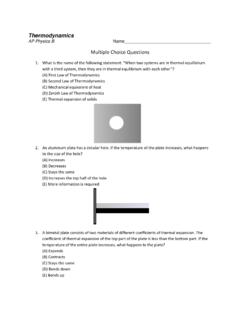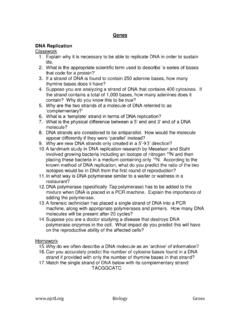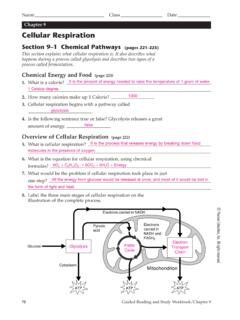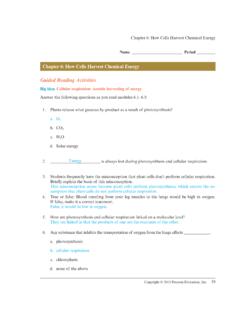Transcription of Multiple Choice Review- Photosynthesis and Cellular ...
1 Multiple Choice review - Photosynthesis and Cellular respiration 1. Oxidation is a. The addition of electrons to a molecule b. The addition of protons to a molecule c. The loss of electrons from a molecule d. The loss of protons from a molecule 2. What molecules are necessary for aerobic Cellular respiration ? a. Glucose and Oxygen b. Glucose and Carbon Dioxide c. Carbon Dioxide and Water d. Water and Oxygen 3. Which process occurs in both aerobic and anaerobic respiration a. Citric Acid Cycle b. Fermentation c. Pyruvate Dehydrogenase Complex d. Glycolysis 4. The process of glycolysis does not require a. NADH b. ATP c. Glucose d. Oxygen 5. Since fermentation occurs in the absence of oxygen, it is a. Anaerobic b. Aerobic c. Cyclic d. Noncyclic 6. Which substance is needed to begin the process of glycolysis? a. Pyruvate b. Solar Energy c. ATP d.
2 NADH 7. Six molecules of glucose would give a net yield of _____ ATP following glycolysis. a. 6 b. 12 c. 18 d. 24 8. How many pyruvate molecules are generated by the glycolysis of 3 glucose molecules? a. 1 b. 3 c. 6 d. 12 9. The buildup of lactic acid in muscle cells is caused by a. The Citric Acid Cycle b. The Calvin Cycle c. Alcoholic fermentation d. Lack of oxygen 10. Which of these is not true of fermentation? a. Follows glycolysis b. NADH donates electrons to the electron transport chain c. Starts with glucose d. Carried out by yeast 11. In which stage of aerobic Cellular respiration is glucose broken down into two molecules of pyruvate? a. Oxidative Phosphorylation b. Citric Acid Cycle c. Pyruvate Dehydrogenase Complex d. Glycolysis 12. Which of the following is not a product of anaerobic respiration ? a. Water b. Alcohol c. Carbon Dioxide d.
3 Lactic Acid 13. Most of the CO2 from aerobic respiration is released during a. Glycolysis b. Pyruvate Dehydrogenase Complex c. Citric Acid Cycle d. Electron Transport Chain 14. What happens during the Citric Acid Cycle? a. The cell releases energy through fermentation. b. Each glucose molecule is broken down into two pyruvate molecules. c. A proton gradient is created. d. Pyruvate is broken down into carbon dioxide 15. When yeast ferments the sugar in bread dough, what is produced that causes the bread dough to rise? a. Ethanol b. Oxygen c. Water d. Carbon Dioxide 16. What is the reduced molecule in the following reaction? Pyruvate + NADH + H+ Lactate + NAD+ a. Lactate b. Pyruvate c. NADH d. NAD+ 17. The immediate energy source that drives ATP synthesis during oxidative phosphorylation is a. The flow of electrons down the electron transport chain b.
4 That attraction of electrons to Oxygen c. The proton gradient created across the membrane d. ATP from glycolysis 18. The final electron acceptor of the electron transport chain is a. O2 b. CO2 c. H20 d. ADP 19. How many ATP molecules are produced per NADH? a. 1 b. 2 c. 3 d. 10 20. How many NADH molecules are produced during the breakdown of one molecule of glucose? a. 3 b. 2 c. 10 d. 12 21. The oxygen needed by Cellular respiration is reduced and forms part of which moleule? a. Pyruvate b. Water c. Carbon Dioxide d. Acetyl Co-A 22. ATP synthase relies on the facilitated diffusion of _____ down their concentration gradient to produce ATP. a. Electrons b. Protons c. Glucose molecules d. Oxygen molecules 23. ATP synthase is an example of an a. Enzyme and Protein b. Protein and Form of Energy c. Enzyme and Form of Energy d. Enzyme only 24. During which stage of aerobic respiration is oxygen necessary.
5 A. Glycolysis b. Pyruvate Dehydrogenase Complex c. Citric Acid Cycle d. Electron Transport Chain and Oxidative Phosphorylation 25. Which of the following is the correct sequence of events in aerobic respiration ? a. Citric Acid Cycle, Pyruvate Dehydrogenase Complex, Oxidative Phosphorylation, Glycolysis b. Glycolysis, Citric Acid Cycle, Pyruvate Dehydrogenase Complex, Oxidative Phosphorylation c. Glycolysis, Oxidative Phosphorylation, Citric Acid Cycle, Pyruvate Dehydrogenase Complex d. Glycolysis, Pyruvate Dehydrogenase Complex, Citric Acid Cycle, Oxidative Phosphorylation 26. Glycolysis is thought to be one of the most ancient metabolic processes. Which statement supports this idea? a. Glycolysis neither uses nor needs oxygen. b. Glycolysis is used by all cells c. Cells were performing glycolysis long before oxygen was present in Earth s atmosphere.
6 D. All of the above 27. Plants must have a continuous supply of _____ for Photosynthesis , but they provide _____ for Cellular respiration . a. Carbon Dioxide; Water b. Carbon Dioxide; Oxygen c. Water; Carbon Dioxide d. Oxygen; Water 28. When the oxygen catastrophe occurred, which organisms died? a. Aerobic b. Anaerobic c. Facultative bacteria d. All organisms 29. During which process is the sun s energy captured? a. Citric Acid Cycle b. Light Independent Reactions c. Calvin Cycle d. Light Dependent Reactions 30. Which chemical is necessary for the absorption of light during Photosynthesis ? a. NADPH b. NADP+ c. Photosystem II d. Chlorophyll 31. Which of the following is supplied to the Calvin Cycle by the light reactions of Photosynthesis a. CO2 and ATP b. ATP and NADPH c. ATP and NADH d. H2O and ATP 32. The oxygen given off by Photosynthesis comes from a.
7 Glucose b. Water c. Carbon Dioxide d. Pyruvate 33. The function of the light reactions is to a. Make glucose b. Make a one carbon sugar c. Produce water d. Convert light energy into chemical energy 34. Which of the following cannot be made by plants using the glucose produced from Photosynthesis ? a. Nucleic Acids b. Proteins c. Starch d. Cellulose 35. In what membrane bound structure do the light dependent reactions of Photosynthesis occur a. Thylakoid b. Nucleus c. Cell d. Chlorophyll 36. The stage of Photosynthesis that uses the most ATP molecules is a. The Calvin Cycle b. The light dependent reactions c. Glycolysis d. The electron transport chain 37. The process by which carbon changes from carbon dioxide to glucose and back is called a. Glycolysis b. The Carbon Cycle c. The Calvin Cycle d. The light dependent reactions 38. How many turns of the Calvin Cycle are needed to create one molecule of glucose?
8 A. 1 b. 2 c. 3 d. 6 39. Which of the following is the reduced form of a molecule used only in Photosynthesis and not in Cellular respiration ? a. NADH b. FADH2 c. NAD+ d. NADPH 40. Which of the following is not a result of increased carbon dioxide in the atmosphere? a. Increase in Earth s temperature b. Decrease in Earth s temperature c. Melting of icecaps d. Dying crops Multiple Choice Answers 1. C 2. A 3. D 4. D 5. A 6. C 7. B 8. C 9. D 10. B 11. D 12. A 13. C 14. D 15. D 16. C 17. C 18. A 19. C 20. C 21. B 22. B 23. A 24. D 25. D 26. D 27. B 28. B 29. D 30. D 31. B 32. B 33. D 34. A 35. A 36. A 37. B 38. D 39. D 40. B















